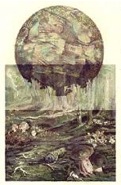Daily News: Paved-over brook may rise again
[Dr. Paul Mankiewicz's work discussed towards end of article.]
New York Daily News
Paved-over brook may rise again
Right now, all you see is a shallow slope - weeds sprouting up out of it - in the cracked, sunbaked asphalt basketball court in Brook Park in Mott Haven. It's hard to believe that once it was a stream flowing from the North Bronx through the southern tip of the borough into the Bronx Kill.
Dreary buildings overlooking the spot and cars whizzing past make it harder still to picture what had been the bucolic home of Indians before it became part of Morrisania, the vast manor of the Morris family, the English merchants who owned pretty much the whole borough.
They used the brook as the eastern boundary of their estate.
In the 18th and 19th centuries, its water powered sawmills, but after the Civil War it was overlaid with concrete and named Brook Ave., lined by apartment buildings and stores.
The arson and urban blight of the 1970s left rubble-strewn vacant lots along Brook Ave. One, at E. 141st St. was turned into an urban greenspace named Brook Park, flourishing as a flower-and-vegetable garden, a quiet oasis off the bustling thoroughfare.
Now Mill Brook - at least a small section of it - may again shimmer and sparkle, as part of an ambitious plan to "daylight" the long-hidden water.
"This is where the brook was," said Harry Bubbins of Friends of Brook Park, stamping his foot in a shallow ditch several yards from the verdant half of the park.
There, farmers from Westchester County were selling the first pumpkins of the season at the weekly greenmarket, and kids in uniforms sat on tree-stump stools and ate after-school snacks.
The first step in the hoped-for return to the past was accomplished with modern technology.
Last summer, a scientist using ground-penetrating radar equipment found the water, estimated to be less than 20 feet below where Bubbins stood.
"You drag it along the ground, like a vacuum cleaner, and it gives a signal of the type of substance - sandy, clay, bedrock," said Dr. Paul Mankiewicz, executive director of the Gaia Institute on City Island and a board member of the New York City Soil and Water Conservation District.
"The [TV] monitor shows what's below. It looks like bound water," Mankiewicz said. "But the resolution wasn't perfect. Cellphones interfere with the equipment."
The gadgetry came from the Department of Agriculture. The military uses similar equipment to search for landmines.
Mankiewicz said it was like taking an X-ray. "It was exciting, like being able to look into the ground, an amazing thing."
He said the brook originated in the Fordham gneiss, one of three types of rock that form bedrock in the Bronx, and flowed to the East River.
"It was probably quite beautiful, flowing over bedrock," he said.
Mankiewicz said he believes it would be the first time that a paved-over natural body of water has been unearthed in the city.
"We have to see if we can get the water and expose it, bring it to the surface, maybe using pumps," said Mankiewicz.
The raising of the brook is part of a development plan for the concrete half of Brook Park, to complement the green side.
The area will be called Harmony Grove, and include a rainbow labyrinth, which is already painted on the asphalt, as well as a circle of fruit trees.
The brook will be the dividing line in the middle of the park, providing a tranquil sight and sound.
Bubbins said his group is working with two City Council members, Maria del Carmen Arroyo (D-Bronx) and Melissa Mark Viverito (D-Manhattan), to build Harmony Grove.
He said the councilwomen have allocated capital funds for the project, and he hopes to break ground by the end of the year.
After more than a century, an ancient stream that formed a thin line of blue through the South Bronx may come full circle.
FAIR USE NOTICE
This site contains copyrighted material the use of which has not always been specifically authorized by the copyright owner. We are making such material available in our efforts to advance understanding of environmental, scientific, and social justice issues, etc. We believe this constitutes a 'fair use' of any such copyrighted material as provided for in section 107 of the US Copyright Law. In accordance with Title 17 U.S.C. Section 107, the material on this site is distributed without profit to those who have expressed a prior interest in receiving the included information for research and educational purposes. For more information go to: http://www.law.cornell.edu/uscode/17/107.shtml. If you wish to use copyrighted material from this site for purposes of your own that go beyond 'fair use', you must obtain permission from the copyright owner.

Thursday, October 12, 2006

